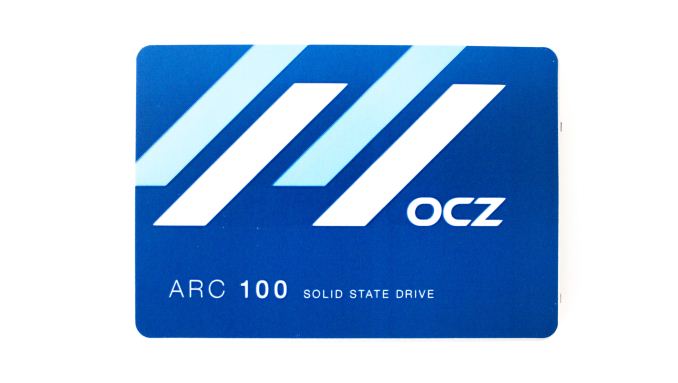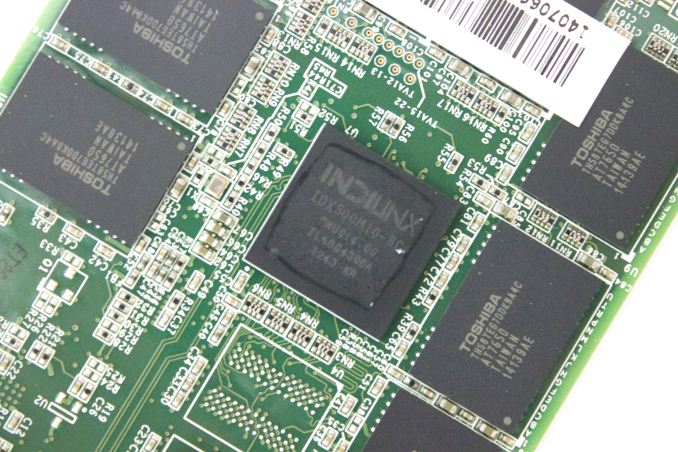OCZ ARC 100 (240GB) SSD Review
by Kristian Vättö on August 26, 2014 7:00 AM EST
Ever since Ryan Petersen, the founder and former CEO of OCZ, resigned almost exactly two years ago, the company has had a new direction. Starting with the launch of the Barefoot 3 platform and the Vector SSDs in late 2012, OCZ has been trying to rebrand itself as a premium manufacturer of high performance SSDs instead of being a budget brand. The old OCZ would have taken the Barefoot 3 controller and stuffed it inside several other models to cater to more price points, but the new OCZ played their cards right. The Vector remained as the only Barefoot 3 based product for months until OCZ introduced the Vertex 450, which was not exactly cheap but a more mainstream version of the Vector with a shorter three-year warranty.
Now, almost two years later after the introduction of the Barefoot 3, OCZ is back in the mainstream SSD game with the ARC 100. The asynchronous NAND from the Agility days is long gone and the ARC 100 uses Toshiba's latest 64Gbit A19nm MLC NAND. In theory the performance will drop a bit but the ARC 100 should hit lower price points. Here's the quick overview:
| OCZ Consumer SSD Lineup | |||||||||
| ARC 100 | Vertex 460 | Vector 150 | |||||||
| Controller | Barefoot 3 M10 | Barefoot 3 M10 | Barefoot 3 M00 | ||||||
| NAND | 64Gbit A19nm | 64Gbit 19nm | 64Gbit 19nm | ||||||
| Sequential Speed | Up to 490MB/s | Up to 545MB/s | Up to 550MB/s | ||||||
| Random Speed | Up to 80K IOPS | Up to 95K IOPS | Up to 100K IOPS | ||||||
| Accessories | - | Cloning Software & Desktop Adapter | |||||||
| Endurance | 20GB per day | 20GB per day | 50GB per day | ||||||
| Warranty | 3 Years | 3 Years | 5 Years | ||||||
The smaller process node NAND and the lack of accessories is the secret behind ARC 100's lower cost. Performance takes a slight hit from the newer NAND compared to the Vertex 460, though that is expected since NAND performance decreases as the lithography shrinks. Fortunately endurance is still rated at the same 20GB per day for three years, which is more than enough for typical client workloads.
| OCZ ARC 100 Specifications | |||||
| Capacity | 120GB | 240GB | 480GB | ||
| Controller | OCZ Barefoot 3 M10 | ||||
| NAND | Toshiba 64Gbit A19nm MLC | ||||
| Sequential Read | 475MB/s | 480MB/s | 490MB/s | ||
| Sequential Write | 395MB/s | 430MB/s | 450MB/s | ||
| 4KB Random Read | 75K IOPS | 75K IOPS | 75K IOPS | ||
| 4KB Random Write | 80K IOPS | 80K IOPS | 80K IOPS | ||
| Steady-State 4KB Random Write | 12K IOPS | 18K IOPS | 20K IOPS | ||
| Idle Power | 0.6W | 0.6W | 0.6W | ||
| Max Power | 3.45W | 3.45W | 3.45W | ||
| Encryption | AES-256 | ||||
| Endurance | 20GB/day for 3 years | ||||
| Warranty | Three years | ||||
| MSRP | $75 | $120 | $240 | ||
Sadly there is still no support for low power states (slumber and DevSleep), so idle power consumption remains high compared to the competition. The same goes for encryption support as the ARC 100 only supports ATA passwords, whereas the industry is moving towards more secure and easily manageable TCG Opal encryption. OCZ's PCIe controller, the JetExpress, will support both, but in the meantime OCZ's SSDs remain limited to the desktop crowd.
The ARC 100 uses the slower bin of the Barefoot 3, which is clocked at 352MHz. The faster version, M00, that is found inside the Vector 150 runs at 397MHz instead, but the two are otherwise the same. Our 240GB sample (256GiB of raw NAND) has sixteen dual-die packages with each die being 8GB (64Gb) in capacity.
Test Systems
For AnandTech Storage Benches, performance consistency, random and sequential performance, performance vs transfer size and load power consumption we use the following system:
| CPU | Intel Core i5-2500K running at 3.3GHz (Turbo & EIST enabled) |
| Motherboard | AsRock Z68 Pro3 |
| Chipset | Intel Z68 |
| Chipset Drivers | Intel 9.1.1.1015 + Intel RST 10.2 |
| Memory | G.Skill RipjawsX DDR3-1600 4 x 8GB (9-9-9-24) |
| Video Card | Palit GeForce GTX 770 JetStream 2GB GDDR5 (1150MHz core clock; 3505MHz GDDR5 effective) |
| Video Drivers | NVIDIA GeForce 332.21 WHQL |
| Desktop Resolution | 1920 x 1080 |
| OS | Windows 7 x64 |
Thanks to G.Skill for the RipjawsX 32GB DDR3 DRAM kit
For slumber power testing we use a different system:
| CPU | Intel Core i7-4770K running at 3.3GHz (Turbo & EIST enabled, C-states disabled) |
| Motherboard | ASUS Z87 Deluxe (BIOS 1707) |
| Chipset | Intel Z87 |
| Chipset Drivers | Intel 9.4.0.1026 + Intel RST 12.9 |
| Memory | Corsair Vengeance DDR3-1866 2x8GB (9-10-9-27 2T) |
| Graphics | Intel HD Graphics 4600 |
| Graphics Drivers | 15.33.8.64.3345 |
| Desktop Resolution | 1920 x 1080 |
| OS | Windows 7 x64 |
- Thanks to Intel for the Core i7-4770K CPU
- Thanks to ASUS for the Z87 Deluxe motherboard
- Thanks to Corsair for the Vengeance 16GB DDR3-1866 DRAM kit, RM750 power supply, Hydro H60 CPU cooler and Carbide 330R case












54 Comments
View All Comments
StevoLincolnite - Tuesday, August 26, 2014 - link
That's true to an extent.I have an OCZ Vertex 2 64Gb SSD which has been fantastically solid for years, if it died and I was able to get it replaced under warranty, I would throw it into a notebook and use the excuse to upgrade the SSD in my main desktop.
That said, the main benefit of an SSD over mechanical that an end-user will notice is not actually the read/write speeds, but rather the 0-latency access times which makes everything feel super snappy and responsive, improved reads/writes are just diminishing returns from an end users experience perspective, hence why I have kept my old Vertex 2 for so long.
hurleydood - Wednesday, December 31, 2014 - link
My old 128GB patriot SSD had a 10 year warranty, failed in 5 years. Patriot replaced it with a latest 240GB SSD they had in inventory. So expect replacements to be current spec.Kristian Vättö - Tuesday, August 26, 2014 - link
Only the 120GB Extreme II is cheaper than the ARC 100 and both have the same 3-year warranty. The Extreme Pro has a 10-year warranty but it is much more expensive.Samus - Tuesday, August 26, 2014 - link
The Extreme II is actually more expensive at all price points except the minimum capacity (120GB) and it isn't always faster, either. The only reason to consider it is for a laptop (where Barefoot 3 makes no sense) if price is a concern.However, I don't see any reason to get anything other than an MX100 for anything except high-performance applications. SleepDev, OPAL, PLP capacitors, solid reliability, lowest price of any SSD at mainstream capacities, and so on...
miandrew - Tuesday, August 26, 2014 - link
Great article. I noticed that the SanDisk Extreme II consistently beats the OCZ ARC 100 and it has slumber power which helps in the laptop world. Nice that Newegg currently has the OCZ sale. So many choices...jerrylzy - Tuesday, August 26, 2014 - link
Why there's no trim validation now?Kristian Vättö - Tuesday, August 26, 2014 - link
I don't usually test TRIM anymore unless we are dealing with a new controller/firmware platform. The Barefoot 3 platform has shown to offer functional TRIM.Witchunter - Tuesday, August 26, 2014 - link
I read this like so: http://i.imgur.com/CMcHBs7.jpg.I agree that there's no need to test it again, but perhaps a reference could be helpful?
Kristian Vättö - Tuesday, August 26, 2014 - link
Haha, a reference sounds like a good idea. I've been trying to streamline the review process to get through my backlog quicker, so that is why it might seem like I'm cutting corners, but I'll take this into account :)Prodromaki - Tuesday, August 26, 2014 - link
Kris, Samsung EVO 256 doesn't cost that much. Its newegg price is 140$. In EU(amazon) for some weird reason MX100 and the EVO are almost the same price(130$ vs 140$). Furthermore the Arc 100 costs ~160$, which definitely makes it a way worse buy than the two other value choices over here.